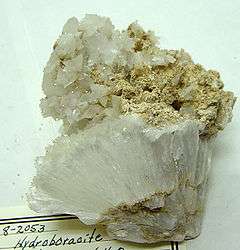Hydroboracite
| Hydroboracite | |
|---|---|
|
Hydroboracite, California(?) | |
| General | |
| Category | Inoborates |
| Formula (repeating unit) | CaMgB6O8(OH)6·3H2O |
| Strunz classification | 6.CB.15 |
| Crystal system | Monoclinic |
| Crystal class |
Prismatic (2/m) H-M symbol: (2/m) |
| Space group | P2/c |
| Unit cell |
a = 11.76, b = 6.68 c = 8.23 [Å]; β = 102.59°; Z = 2 |
| Identification | |
| Colour | Colourless, white |
| Mohs scale hardness | 2 |
| Luster | Vitreous, silky |
| Diaphaneity | Transparent |
| Optical properties | Biaxial (+) |
| Refractive index | nα = 1.520 - 1.523 nβ = 1.534 - 1.535 nγ = 1.569 - 1.571 |
| Birefringence | δ = 0.049 |
| 2V angle | Measured: 60° to 66°, calculated: 62° to 66° |
| Dispersion | Relatively weak |
| Solubility | Very poorly soluble in cold water. Partially dissolved by prolonged submersion in boiling water. |
Hydroboracite is a hydrated borate mineral (hence the name) of calcium and magnesium, whose chemical composition is CaMgB6O8(OH)6·3H2O. It was discovered in 1834 in Atyrau Province, Kazakhstan. Hydroboracite is a minor borate ore mineral.
References
This article is issued from Wikipedia - version of the 11/20/2016. The text is available under the Creative Commons Attribution/Share Alike but additional terms may apply for the media files.
